#was inspired by sadie’s new haircut
Explore tagged Tumblr posts
Text

elmax guitarist max & fashion designer el
#was inspired by sadie’s new haircut#but also i just love that picture of millie with the jonas brothers shirt#stranger things#elmax#jane el hopper#el hopper#lesbian el hopper#max mayfield#moodboard
123 notes
·
View notes
Text

season 4 max + s5 max concept inspired by sadies new haircut :)
177 notes
·
View notes
Text
Steven Universe Podcast: Volume 2, Episode 5: Connie
In the second season of the Steven Universe Podcast, episode 5, released February 22, 2018, is about Connie! The official description:
We're spotlighting Steven Universe's best-friend, Connie, on the Steven Universe Podcast! Grace Rolek, who voices Connie, and Zach Callison, the voice of Steven, talk about their characters' friendship, and recent struggles on the series. And creator Rebecca Sugar and former EP Ian Jones-Quartey explain Connie's sword, her relationship with the Gems, and the yin & yang that dictate Connie and Steven's respective designs and personalities. Plus, Connie drops in to talk about school, Stevonnie, and her fabulous new haircut!
As per usual, the podcast is on the long side, so I'll open with bulleted highlights and include a more detailed narrative under the cut.
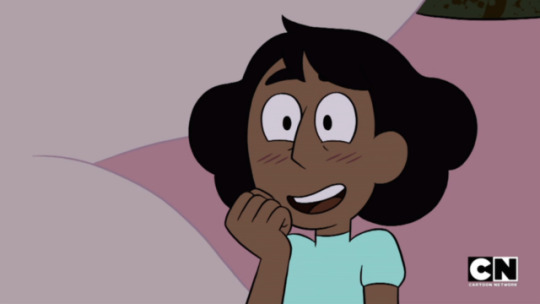
Highlights:
Connie has been planned as a character since the beginning; drawings of her are included in Rebecca's original sketchbook.
Connie is designed as a foil for Steven, with each of them possessing traits the other lacks so they can fit together smoothly.
Associating Rose's sword with Connie early on was a deliberate decision; they always wanted her to be the sword of the relationship, complement to Steven's shield.
The Gems treat Connie better than any other human and respect her as a member of the team.
The Gems talk to Connie's parents outside what we see on the show; they've been communicating with the Maheswarans a lot more since Connie decided to be upfront with them about her involvement with Steven.
The Cool Kids are partially based on Rebecca's college experiences when she joined a band. She was pseudonymously known as Rebecca Murder.
Lapis and Peridot making art in the barn was based on Rebecca's band member friends using a barn for their art.
Nanefua as Dewey's opponent was planned very early too. They always made sure to include her as a critical voice in the crowd when the town was gathering to react to his speeches.
The boardie character who's designed to look like Ian Jones-Quartey was originally going to be a pizza merchant named Everett, but they went from having a Pizza Man based on him to having a Pizza Family based on Ian's family.
There was also a boardie named Baby originally, and some ideas associated with him got rolled into Fryman family characters, especially Ronaldo.
Ian Jones-Quartey says if you are a fan of Steven Universe and you haven't read the book Keep Beach City Weird, you're doing yourself a disservice.
Grace Rolek and Zach Callison both felt that the Connie/Steven angst from "Dewey Wins" to "Kevin Party" carried an authentic sense of what it's like to have relationship drama. Both invoked their own breakups which were reminiscent of some aspects of those interactions.
Grace and Zach are pleased to be past their "teenage angst" phase now that they're both twenty. They’re glad to have just regular angst now.
Grace thinks Connie cut her hair to help move past the need to define herself entirely through her relationship with Steven; she needed a change and some definition as her own person.
Grace, in character as Connie, says her favorite subject in school is science so she might study gems when she grows up, she'd love to go on another adventure with the Crystal Temps as long as she doesn't have to imitate Steven, and being in a Fusion is weird but awesome--and she'd be Stevonnie's left arm because she's left-handed.
Next week: Lapis!
The detailed summary, including Rebecca and Ian discussing Connie’s characteristics and character design; discussions of early boardie character concepts; Grace and Zach discussing Connie's relationship with Steven and recent developments; and fan questions answered in character . . .
Read it all below!
Rebecca Sugar and Ian Jones-Quartey:
McKenzie begins by presenting a discussion of Connie and the humans of Beach City, also known as the boardies. Ian opens with a complaint that the term "boardies" doesn't seem to be catching on with fans even though they've been termed that in the show. He doesn't know why some fans like to call them "townies."

McKenzie asks how early Connie was conceived for the show, and both guests say she has been part of the show since the beginning. When McKenzie asks whether Connie was always intended to eventually join Steven's battles as a participant, Ian says they had always intended a group of humans to have various relationships with the Gems--either on the outskirts as background characters, as interested parties, or as participants in their activities. These ideas for different characters were distilled into one in many cases, and Connie absorbed a bunch of their intentions for heavily involved human characters.
Rebecca says Connie's character design was intentionally a complement to Steven's, right down to their faces fitting together like puzzle pieces. Connie is reasonable and down to earth, while Steven is whimsical and magical, with both of them being attracted to what the other represents.
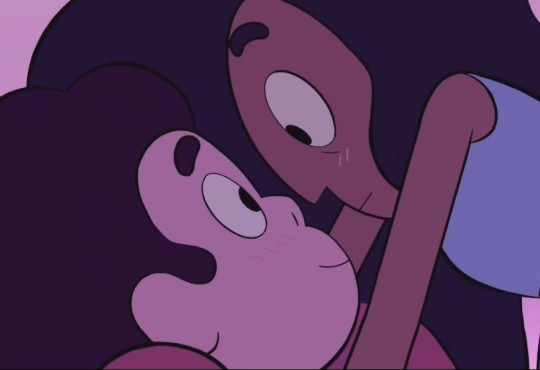
Together, Connie and Steven make the "ultimate person," which is why Stevonnie works so well as a wielder of the sword and shield. Associating Connie with the sword very early on was intentional; way back in "Lion 2: The Movie," Rose's sword's first appearance was deliberately done during a Connie episode so she could be there to help Steven use it against the Robot Shooty Thing.
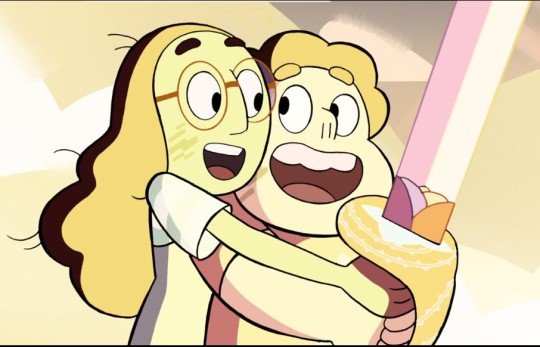
McKenzie prompts Ian and Rebecca to discuss Connie's relationship with the other Gems besides Steven. Rebecca immediately brings up one of the first times all of them interact with her, in the beginning of "Lion 2: The Movie" when they warp in standing in cool poses. (That was a Jeff Liu drawing.) They really wanted to help Steven have a friend, enhancing his cool life to draw Connie in, even if they're not completely sure how to do that. Ian says they actually treat Connie better than they treat any other human. She's a full-on member of the team as Steven's best friend, fusion partner, and dedicated combatant, so she gets special treatment.
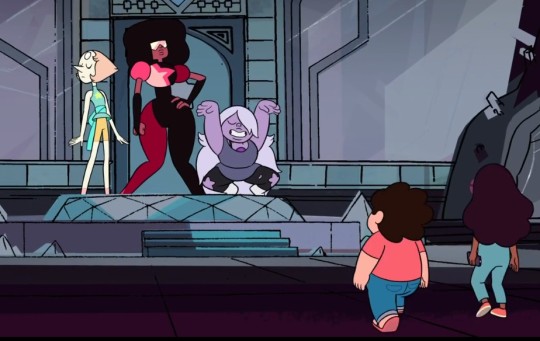
Rebecca comments that since Connie opened up to her parents about her role on the team, the Gems have actually been in more communication with Connie's parents about it, which we don't see onscreen because the perspective of the show is tied to Steven. Rebecca and Ian say it's implied pretty strongly in "Gem Hunt" that Pearl knows Connie's parents' rules. Ian thinks the conversations between Pearl and Priyanka would be "pretty boring." And Garnet, as shown in "Mindful Education," now respects Connie, Steven, and Stevonnie (each as their own person) in a more mature, "equal" way than she used to when it was more about just protecting them.
McKenzie brings up changes with the other boardies (naming Mayor Dewey and Lars and Sadie), asking Ian and Rebecca to comment on why they decided to introduce so many changes to their lives. Sadie was shown in "Sadie's Song" wanting to make changes in her life, and now in the latest episodes she's evolving to find out who she is without Lars to rely on. She thought no one really wanted to be friends with her, but although she had Lars around, she was discontent with who she was and thought nobody who was actually cool would accept her.

The Cool Kids are said to genuinely like Lars. Sadie's experience in the band with them is based partially on Rebecca joining a band in college. They called her "Rebecca Murder." And after Rebecca left to work on her animation career, those band members began making art in a barn, inspiring what Peridot and Lapis did there.
Ian says Mayor Dewey's loss to Nanefua as mayor was planned early too; they always made sure to stick Nanefua into crowd scenes where Dewey was getting criticized. Rebecca reminds us that Nanefua is based on Ian's grandmother.
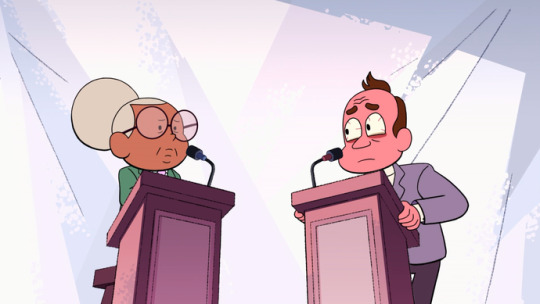
And Ian brings up the voiceless character that's supposed to be him on the show--that he keeps getting prominently drawn in the crowd ever since he left the show. He was originally a pizza man they think was named Everett, but that idea blossomed into the Pizza family based largely on Ian's family members.

They also discuss another character that didn't get used--a scooter-riding character named Baby who threw cans of soda at people. (??) They think he kind of thought of himself as an action hero but may have morphed into the Fryman family. (Ronaldo got some of his traits, as he's interested in the Gems.) The Keep Beach City Weird book comes up and Ian says you should read it if you're a fan of the show. (McKenzie admits that she hasn't read it. Author’s note: It’s great, I reviewed it.) They bring up the blog that the writers would use for extra-canon material, expertly timing posts to line up with the show's airing of related episodes. (Koala Princess was first mentioned on Ronaldo's blog and later was incorporated into the show.) McKenzie wishes she could know more about the concept characters like Baby.
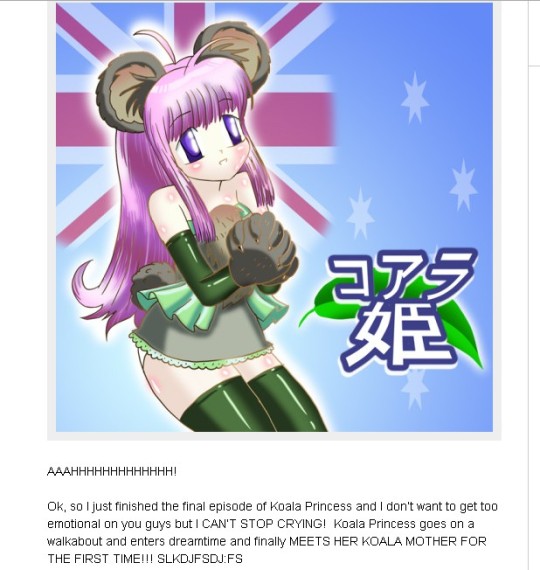
Grace Rolek and Zach Callison:
In the wake of so many changes--Dewey stepping down, Sadie quitting the Big Donut, Lapis leaving--McKenzie prompts Grace to comment. Grace thinks there's a huge shift happening; unlike most cartoons where most elements stay the same, Beach City is moving on to a new era. (Zach starts singing a line from a Hamilton song: "The world will never be the same!") Zach thinks even though Steven and Connie have reconciled, there's still the unsolved murder mystery and there's no going back to the status quo. McKenzie thinks it's huge that Sadie left her job, considering the literal first scene of the show is Steven inside the Big Donut with her comforting him about Cookie Cats. (Grace also quotes Hamilton, saying "The world's turned upside down.")
When McKenzie asks Grace to discuss how she can bring authenticity to the story as it's changing, she says she's changed a lot herself from age 15 to age 20 on the show, so she's gotten life experience as the characters have and can relate more readily. She can pulled from her own experiences with, say, breakups, to filter those emotions into giving voice to Connie in her struggles with Steven. Zach comments that Grace was not there during his recording for "Kevin Party," and he remembers having a personal emotional reaction in response to the dialogue. (He later returns to this to express that it was where Kevin was giving Steven terrible advice; he had that happen to him too.)
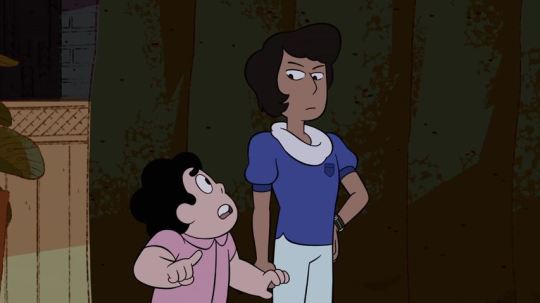
Grace says good writing really helps connection on a personal level; it automatically feels authentic. Grace adds that even though she's never fought Gem monsters or had a magical best friend, she still knows on some level what it's like to go through what Connie does in those moments because the writers build them on realistic emotional experiences.
McKenzie says she thinks Steven's emotional misfire at the beginning of "Dewey Wins" was very unlike him, and asks for the actors' comments on whether they think Steven was genuinely confused about Connie's reaction or whether he was suppressing something. Zach thinks Steven probably got it subconsciously, but was just confused about everything at the time. Grace thinks Connie just felt terrified about having faced the idea of not seeing Steven ever again and then when he returned he was so flippant about their pact, which she had invested so much into even if her ability to help might have been limited in that situation.
Zach points out that anything bad that happened to him at age 14 was the end of the world. Zach and Grace joke about how nice it is to say "when I was a teenager" now that they're past that into their twenties. (Their birthdays are two weeks apart.) Grace says she just has normal angst now instead of teenage angst.
McKenzie brings up "Gemcation" and Steven's embarrassment to admit that he'd had a fight with Connie, worrying that they would side with her. What do Zach and Grace think of Steven's atypical reticence? Zach thinks Steven fears the Gems' reaction would be to be angry like Connie because he must deserve that treatment. When McKenzie suggests it would've been simpler to just leave and never come back to face it, Zach says that's the darkest timeline and jokes that Steven would join the Diamond Authority. This AU definitely exists.
The next subject is Connie's hair. Grace is asked to comment, and she remembers seeing it in the boards and asking about it, with Rebecca confirming that Connie had gone through a redesign.

Grace says it's a common cliché to change your hair when you go through a relationship change, but there's truth in it. She thinks Connie's come so far from Season 1, from thinking she's going to die friendless to showing up at a cool party with a Lion and a new haircut, chatting with strangers. Grace thinks she may have changed her hair to help deal with moving forward, and although her relationship with Steven is very important to her, she needs to invest in her personal growth independently from having a magical best friend. Grace mentions feeling sort of bad for Kevin for the first time in that episode, despite his history of being unsympathetic. McKenzie thinks his past with having an ex he lost helped humanize him. They agree he deserves some sympathetic treatment but that he's still a jerk, and they joke about a redemption arc for him in which he'd have to sing and join the Crystal Gems.
Connie answers questions:
McKenzie: What do you want to be when you grow up?
Connie: Oh, I have no idea. Right now my favorite subject in school is science, so I'd love to do something with that, I think, learning and investigating the world is super interesting. Maybe I could study gems for a living.
McKenzie: Would you consider going on another adventure with the Crystal Temps?
Connie: I'd love to! I just hope they don't make me imitate Steven again. That was kind of weird. If we could just be our own people while doing an adventure, that'd be fun!
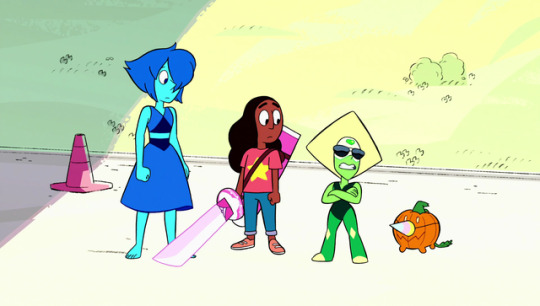
McKenzie: What's it like to be in a Fusion?
Connie: It's super weird but it's awesome. I mean, it's crazy, I get to share a mind with Steven.
McKenzie: Yeah?
Connie: Yeah, it's like, half of me is controlling half a brain and half a body, but at the same time it's just one person.
McKenzie: Is it like divided down the middle? Do you have like the right arm?
Connie: I guess. I mean, I'm left-handed, so it'd be the left arm.
McKenzie: Why did you cut your hair? Which by the way looks amazing.
Connie: Thank you! I think I just needed a change. I feel like, I'm growing up, and I've had this long hair for a real long time, and I wanted to assert a new side of my personality.
McKenzie: It's an image change, you gotta shake things up!
Connie: Exactly. I've had this long hair for a while now, and now this cute short hair, it's a cute chic new look.
McKenzie: What kind of podcast would you have if you had a podcast?
Connie: I would LOVE to have a podcast because I just love to talk about all sorts of things that interest me. It would be cool if Steven and I could get together and talk about all sorts of stuff. Maybe we could interview the Gems or interview people about--or I'd love to talk about all sorts of issues in the world today. I love to talk about the real stuff. Current events. And also pop culture, too, I think, books, television, movies, analyzing it all.
McKenzie: That sounds like an amazing podcast.
Connie: Thanks. I mean I certainly love talking to you on this one!
Next week: LAPIS!
[Archive of Steven Universe Podcast Summaries]
#steven universe#steven universe podcast#connie#grace rolek#zach callison#mckenzie atwood#rebecca sugar#ian jones-quartey#myblog
898 notes
·
View notes
Text
[ad_1] As POPSUGAR editors, we independently select and write about stuff we love and think you'll like too. If you buy a product we have recommended, we may receive affiliate commission, which in turn supports our work. "Stranger Things" season four delivers a new wave of supernatural mayhem, questionable haircuts, and, of course, fashion inspiration. With the latest episodes partially set in the fictional town of Lenora Hills, CA, there's a noticeable shift in the cast's wardrobe to channel the laidback California aesthetic of the '80s. Think: patterned button downs, graphic tees, and pastel colorways galore. As it turns out, not every outfit worn on screen was culled from a vintage store; some were made specifically for the show in partnership with Quiksilver, and fans can shop the exact pieces online right now. The Netflix show's costume designer, Amy Parris, worked with Quiksilver over the span of three years to create a collection of clothes inspired by '80s surf culture, digging into the brand's archives to revive designs from the time period. These re-created styles pop up on main characters and extras throughout season four, and include Nancy Wheeler's (Natalia Dyer) denim jacket, Max Mayfield's (Sadie Sink) blue and yellow zip-up, and much of Argyle's (Eduardo Franco) wardrobe. Parris and Quiksilver also produced additional apparel and accessories, so fans can rep Surfer Boy Pizza, the Hellfire Club, Lenora Hills, and the Upside Down. "Quiksilver was an integral part of California fashion in the 1980s," Parris told Gear Patrol. "['Stranger Things'] is so true to the period that it only made sense to infuse Quiksilver archive pieces through the show this season. Together, Quiksilver and I worked meticulously to make sure the fit, fabric, and feel of each garment was both true to the period and akin to the characters' closets." The "Stranger Things" x Quiksilver collaboration includes T-shirts, shorts, jackets, sunglasses, hats, bags, and even swimsuits, with prices ranging from $25 to $160. Read ahead to shop several outfits worn by characters in season four, along with our favorite picks from the nostalgic collection. window.fbAsyncInit = function() FB.init( appId : '175338224756', status : true, // check login status xfbml : true, // parse XFBML version : 'v8.0' ); ONSUGAR.Event.fire('fb:loaded'); ; // Load the SDK Asynchronously (function(d) var id = 'facebook-jssdk'; if (d.getElementById(id)) return; if (typeof scriptsList !== "undefined") scriptsList.push('src': 'https://connect.facebook.net/en_US/sdk.js', 'attrs': 'id':id, 'async': true); (document)); [ad_2] Source link
1 note
·
View note
Text
So How About Them New Episodes, Ammirite Ladies??
here’s what i thought of the new episodes via live reactions as i watching them!
overall, it was kinda underwhelming but there were parts that i really did like! and if you liked these episodes, that’s awesome!
MAYOR DEWEY WINS
was this title a reference to the movie/book John Dies at the End, cause if so then i’m shocked i caught that
apparently it is, would you look at that. btw i kinda liked the movie.
damn, Sadie took this hard. and Steven never told Lars’ parents. so i guess Sadie has to do that herself.
why tf does Steven care if Dewey wins?!
OH, IT’S BECAUSE HE DON’T WANT SHIT TO CHANGE AND HE THINKS HAVING A NEW MAYOR WOULD BE BAD WTF DEWEY DOES NOTHING
ok wow, there’s only 24 people in Beach City and he never noticed that Lars was gone!?
“is that why the donut shop was closed?”
“we’ll hire a new donut boy!” DEWEY. DUDE. ARE YOU FOR REAL?!
“high school mayor” lmao
how did he run unopposed for 10 years!?
LARS’ MOM KEEPS A SHITTON OF TOMATOES IN HER PURSE SHE READY TO THROW DOWN ALL THE TIME
i don’t like that Steven is so adamant on Dewey winning.
jesus, Steven, let Nanefua win. she’s obviously the better person for the job
“i’m done pointing my finger at you, and now i direct all my fingers on both my hands to the citizens” top 10 anime deaths
NANEFUA WINS, OH MY GOD YES
STEVEN, DUDE, REALLY?! LEAVE CONNIE ALONE!
“i don’t know what you’re talking about, but i need to get a new job” 2018 mood tbh
episode rating: 2 tomatoes out of 5. i can’t stand Steven in this episode at all. but hey, NANEFUA WON!!!!!!
RAISING THE BARN
....was Lapis’ main concern that Steven dropped his phone on Homeworld? not the fact that he was... idk... ON HOMEWORLD?!
ok Lapis is ready to bail immediately and tbh i dont blame her
did she just uproot the entire bard wtf?!
BARN THE DIAMONDS, BARN THE DIAMONDS, BARN THE DIAMONDS!
episode rating: 1.5 barns out of 5. BARN THE DIAMONDS, BARN THE DIAMONDS, BARN THE DIAMONDS!
GEMCATION

^ mfw Amethyst basically spat an egg out her mouth (it was kinda gross)
well. Greg got some kinda house.... still don’t get why the crew is so against having Greg get a house
also, where’s Peridot?
“remove all shoes before entering” Pearl fucking THROWS A RANDOM ASS PAIR OF SHOES
OKAY PEARL SCREAMING “PARTY GUY, NO!” WAS ACTUALLY KINDA FUNNY
S H O W M E P A R T Y G U Y Y O U C O W A R D S
“Steven, you should join me. become a raisin” ok Garnet
did. did Steven completely cut Garnet off as she was talking about Pink Diamond and the Gem War with the whole, “yeah, yeah, i get it, Mom. i already heard this story” kinda thing? B R U H that ain’t okay
AND GARNET JUST SHUTS UP AND WAS LIKE “good, you understand”
PEARL WAS GONNA STRAIGHT UP ADMIT TO SOME HUGE THING AFTER HER “THERE ARE THINGS THAT ARE IMPOSSIBLE FOR ME TO EXPLAIN” LINE AND HE CUTS HER OFF WITH “CONNIE HATES ME”
WHY COULDN’T STEVEN AT LEAST TELL THESE FOUR THAT HE WAS SO WORRIED ABOUT CONNIE HATING HIM?!
I’M KINDA GETTING SICK OF SEEING STEVEN MOPE LIKE THIS FOR 3 EPISODES STRAIGHT AND I HOPE HE DOESN’T KEEP THIS UP FOR THE NEXT 2
OH NO, PLEASE DISREGARD ALL OF THE MESSED UP THINGS YOU SAW ON HOMEWORLD CAUSE CONNIE IS (rightfully) UPSET WITH YOU. LARS D I E D.
GUITAR DAD SAVES THE DAY
i love Greg Universe
how would you not notice if you aren’t getting any service on your phone? your phone tells you when you’re getting service or not
bruh you almost made your dad drive off a cliff for you to get phone service
Greg Universe is a ride or die kinda guy
this ending shot is cute, i’ll give you that.
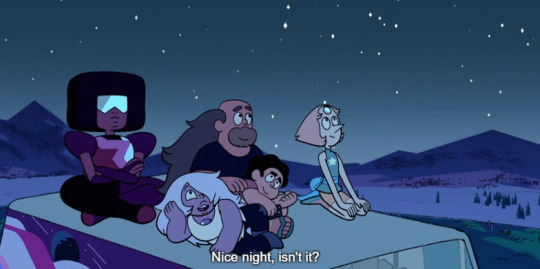
episode rating: 2 party guys out of 5. Party Guy should’ve bitten Steven’s phone and his shit attitude. also PEARL WTF ARE YOU TELL US ALREADY
BACK TO THE KINDERGARTEN
Connie i miss you
“of the three things i have to do in the sink now, this is the one i least mind you seeing” B R U H
Peridot listens to country music, this is disgusting
HOLY SHIT AMETHYST IS TOSSIN’ PERIDOT AROUND LIKE SHE WEIGHS NOTHING AND I’M CRACKING UP
“can i bring my music?” “NO.” damn Amethyst you already threw Peri around like she ain’t nothin’, let her bring her music if it’ll help her
aaaay, they’re in the train again!
dang, Peri really loved the barn.
i kinda like that Amethyst is going around trying to figure out which member of the Famethyst came out of which part of the Kindergarten. kinda cute.
so everything is seriously determined by the nutrition, right down to the style of a Gem’s hair? ...huh. iron deposits determine hair styles.
damn, Peri went with a sucker punch to the gut with her little speech about how Kindergartens kill off life and are just “lifeless husks” once all the Gems are done being formed. and Amethyst feels awful about it, dang.
ok. there’s a flower growin’ in the Kindergarten, and that should technically be impossible due to all of the nutrients in this one area being used up. this could be interesting.
ok, so now the trio is gonna farm & see what happens. ok, ok, i can roll with this i guess.
FARMING MONTAGE
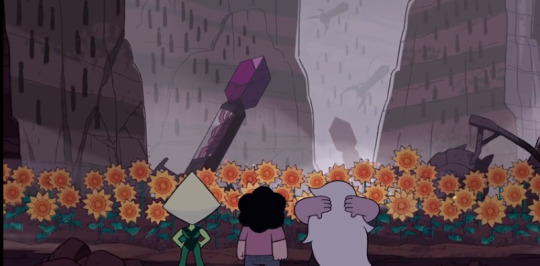
look at them flowers
they proud
don’t make Peri live here
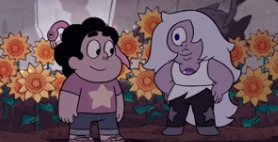
why the flamingo thingy taller than both of them
gods i didn’t need to see Steven happily showering
they’re talking about how the flowers are probs gonna look beautiful i bet they all died, they’re too positive about this. $5 them flowers are dead.
them flowers are dead,
...now they’re arguing, cause Peri blew up on them. alright. this ain’t good.
aaaaaaaaaaaand Peri crushed the original flower that grew here. both Steven & Amethyst made pained whimpers. ok. this ain’t good.
oh it’s a Gem creature- haven’t seen one of those in a while!
IT ATE PERIDOT HOLY FUCK
SMOKEY QUARTZ IS BACK
ngl i like Smokey’s theme music
btw there’s no dialogue from Smokey, just a quick 2 second thing
Peri doesn’t reform with a star on her
ok, that was kinda cute. and having a technician that also likes gardening is cute too
episode rating: 3.5 dead sunflowers outta 5. it was an okay episode & i did like it.
SADIE KILLER
heh, i get it. cause lady killer.
oh god, that looks bad
WHY IS THAT MOP SO BIG
instead of reading off a long-ass list to the overly worked employee, just hand Sadie the list so she won’t fuck up?
“and a coffee. hold the coffee.” same tbh
oh. he’s in a band with the Cool Kids. WE GET TO SEE THE COOL KIDS!
“...i hope he [Lars] is safe and all, but working all these shifts by myself has been a huge drag” GIRL, LARS DIED IN SPACE AND IS STILL THERE
Steven stealing all the napkins is something i’d do tbh
man, i love the Cool Kids
is my girl Jenny rockin’ the bass? aaaaaaaaaaay!
Sour Cream, what the HECK IS RAP-A-BILLY?
“Doo-doo. Butt. The government corrupts” Buck is the voice of this generation

welcome to EB Games
they... they admitted to following her home from work....
“doo-doo. i think i broke your bed” Buck wtf
also, i guess them watching all of Sadie’s horror movies gave them inspiration to do that weird donut-brain-eating song. weird.
“we are the working dead, and we lurch for minimum wage” same Sadie
......ok, she’s freaking everyone out. and they look uncomfortable. Sadie, seriously stop. they’re concerned.
...she. put lipstick on her eyes.
see, if she wasn’t freakin’ everyone out with this, i’d say this song is a bop.
ok they’re fine now & thought it was lit ok cool cool cool. i ain’t a big fan of the lyrics tbh, but i do like the song.
“aww, doo-doo”
ok so Steven’s askin’ for advice on how to write horror-themed songs from Sadie. how about LARS DIED ON HOMEWORLD
SADIE’S ADVICE IS:
LOSE YOUR LIFE TO A BORING JOB
LOSE THE ONE PERSON YOU WERE CLOSE TO
LOSE YOUR MIND WORKIN A TON OF SHIFTS
GIRL FOR THE LOVE OF GOD
Steven puttin’ Sadie on blast, good lord he just sang an accidental roast tryin’ to sing shit like she does
HE STOLE ALL THE NAPKINS AGAIN
“you can’t help being cute no more than i can help being cool” Buck, you’re a blessing
“yoooooo, what if this is all a dream?” Buck, wtf?
oh. Sadie’s goin’ with them. okay.
OH. SHE QUIT HER JOB. UM. OKAY?
episode rating: 3 funky riffs out of 5. Buck Dewey is great.
KEVIN PARTY
I DO NOT WANT TO WATCH THIS EPISODE, BUT IMMA DO IT ANYWAY
DIDN’T EVEN START THE EPISODE AND I STILL FEEL UNCOMFORTABLE
let’s just get this over with...
why’d Steven wait this long to track down Lion?!
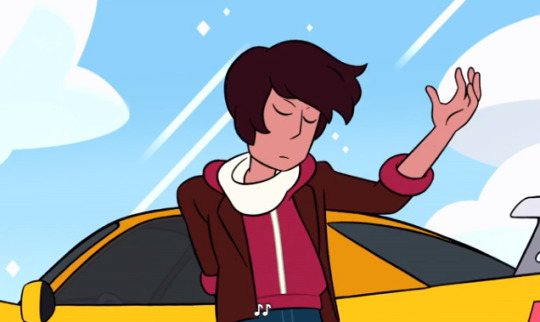
siiiiiiiiiiiiiiiiiiiiiiiiiiiiiiiiiiiigh, here he is......
gods, i still hate him
stop being gross to kids, leave Steven and Connie alone ya freak
at least he knows they use they/them pronouns.
how did he find out where Connie is? doesn’t she live far away from Beach City? did he track down these two kids just to “invite” Stevonnie?!
“no one turns down an invitation to a Kevin party” i sure as fuck would
lmao Kevin has an old phone
“your name’s Steven? weird, i thought your name was Clarence” OI, DON’T INSULT CLARENCE LIKE THAT
rude, Steven brought snacks and ya just toss ‘em into the void?
ok. he’s creepily obsessed with Stevonnie cause apparently they make parties and shit like that hella fun. um. stop? being obsessed with kids??
WTF WHY IS LION AT THE PARTY
Connie actually showed up. and had Lion the entire time. that’s. super fucked up. Lion is the ONLY way to get to Lars directly!
and also, there’s TWO KIDS AT A PARTY WITH OLDER PEOPLE?! NO ONE BUT DERRICK QUESTIONS THIS?
Kevin’s gonna try to get them to talk to each other... so they can form Stevonnie... so his party won’t suck...
also, he keeps calling them 7-year-olds........ siiiiiiiiiiiiiiiiiiiiiiigh, ok Kevin.
KEVIN YOU IDIOT LET THEM TALK TO EACH OTHER SO HE CAN SAY SORRY DON’T GIVE HIM YOUR “COOL GUY” BULLSHIT
“i need those old people to whisper my name when they die” tbh goals
“who’s Sabina?” Kevin got all red in the face and almost lost his cool
so Kevin’s gonna try to make Steven look like he’s moved on from Connie or some shit. this won’t end well.
NO, NOT DERRICK’S JACKET
now we get a montage of 2 kids being uncomfortable surrounded by older people at a party they should’t be at, ok.
at least Connie looks cute. and she got a haircut! so cute!

NOT CUTE NOT CUTE NOT CUTE
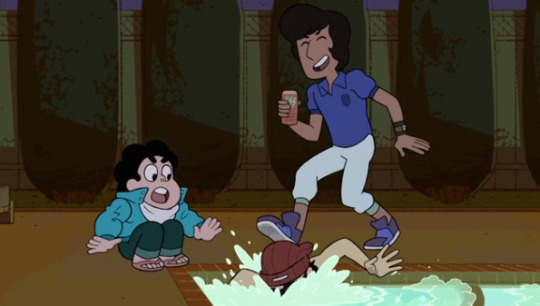
GOD, I HATE KEVIN
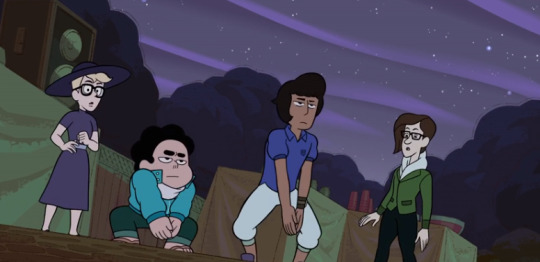

Steven, what are you doing?
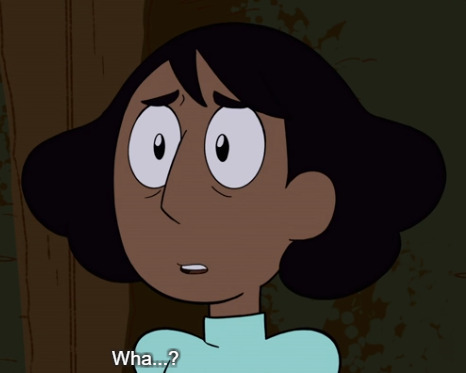
STEVEN, WHAT ARE YOU DOING?
ok, quick recap cause i didn’t mention this: Kevin thought Steven & Connie were dating, so, Connie only went to the party to see if Steven’s okay and if they could talk. Steven decided to follow Kevin’s advice for some reason, and Connie thinks Steve’s new BFF is Kevin, and Kevin has no concept of what friends are.
so. Connie didn’t text Steven cause she preferred talking face to face about this, and that texting him wasn’t good enough to work out these issues. very fair point. still don’t get why you legit stole Lion from him, but the not texting back thing makes complete sense.
ok, she rode Lion to his house while Steven, Greg & the Gems were away (the episode Gemcation). and that’s when she bumped into Kevin and got the invite. ok. now Kevin is slightly less creepy, but still disgusting nonetheless.
oh, yay! they’re talking it out! and Steven isn’t disregarding Connie’s anger!
yay! they’re friends again!
don’t form Stevonnie, don’t form Stevonnie, don’t form Stevonnie, don’t form Stevonnie, don’t form Stevonnie, don’t form Stevonnie, don’t form Stevonnie, don’t form Stevonnie, don’t form Stevonnie, don’t form Stevonnie, don’t form Stevonnie, don’t form Stevonnie, don’t form Stevonnie.
LMAO GET FUCKED, KEVIN, THEY AIN’T FORMIN’ STEVONNIE
episode rating: 1 Lion out of 5. least fave episode, tbh. but hey, we got Connie back!
41 notes
·
View notes
Text
Steven Universe Spoilers
Spoilers for the new eps that just came out
Season five eps 5-10
Spoilers! Don't read this post.
Wow, so I guess the theme of this new Steven bomb is: everything changes.
Sometimes the changes are big, sometimes the changes are sad, but the changes have to happen, it makes us grow as people.
It was kind of nice to see Steven having the character issue and lesson to learn this time, and I'm glad he got it sorted out in the end.
It's.... it's sad that Lapis left but like... would anyone really agree that it would have been better for Peridot to go with her? I mean I think that's actually a really good lesson. You have to be honest about what you want, even with the people you care about, especially with them. And when you are honest, you don't always get rewarded for it. Sometimes it hurts. Sometimes it hurts for a long time. But it's better for you in the end.
Character development: Peridot mercilessly crushing the broken robioid with her foot in the first ep we see her in, vs stomping on the not-flower in anger then immediately feeling remourse for it.
Yikes! Who else got Trump and Clinton vibes from the mayor debate? It's a shame the real world doesn't go so sensibly. :( I really liked that Steven was supporting Dewey, even though like... he's really not a good mayor at all. Steven has bad judgement too sometimes, and his affectionate feelings for Mayor Dewey have blinded him to the fact that Nanefua really would be a much better mayor for Beach City.
I...... really liked and related to the working dead song of course, I relate to sadies predicament, but were there any older viewers who felt........ not excited when she announced she had quit?
Like. That's always the answer in movies and shows, isn't it? You work in a dead end job and the only way out is to dramatically quit one day and pursue something crazy. I don't actually feel happy or inspired watching that. I feel like that's not any kind of viable option for me ever. I have three kids to support and rent to pay. I can't just quit my job and go live in my mom's basement until my art career pans out. What would make me feel inspired is to watch someone keep at the shitty job but make it work somehow. Watch a character fight for better treatment at their job, watch a character balance the job with interests and social plans, watch a character learn how to deal with stress, and find some kind of happiness AROUND the shitty job.
I don't know. I just. I'm happy for Sadie but the ep didn't make me feel happy. Oh well. This isn't a show for 34 year old single moms, it's a show for kids, so.
AND PEARL
JESUS CHRIST
WHAT WERE YOU GOING TO SAY
And Connie looks cute with the haircut.
It's really exciting to see all the growth and changes in these six little eps. I wonder what's going to happen next.
3 notes
·
View notes
Text
The 15 Best Booths at Art Basel in Miami Beach
This year’s edition of Art Basel in Miami Beach features 268 galleries from 35 countries, located in the newly reconstructed Miami Beach Convention Center. While many hewed to typical fair conventions—pristine white walls and a concrete floor—the more ambitious presentations ran wild. From a bodega to a backyard, artists’ imagined spaces dramatically altered the mood, infusing a sense of fun and intimacy into the behemoth of a building. Below are 15 of our favorite presentations.
Josh Lilley
Nova, Booth N24
With works by Derek Fordjour

Installation view of Josh Lilley’s booth at Art Basel in Miami Beach, 2018. Photo by Nicholas Knight. Courtesy of Josh Lilley.
Josh Lilley transported five tons of pea gravel to the convention center in order to transform his booth into a faux-backyard lot. Rusty metal siding lines the walls. A pair of sneakers hang by their laces from a beam above the booth. Together, these elements transform the typical, white-walled booth space into a gritty, atypical art venue within which New York–based artist Derek Fordjour has mounted highly textured paintings that depict cheerleaders, marching band members, and tailors. A sculpture, Burden Cycle (2018), consists of an elevated and light-studded steel wheel. Altogether, the presentation is both raw and celebratory, carnivalesque yet thoughtful. It also subtly considers ideas of labor—such as the divides between people who erect siding or lay gravel, and those who make and sell paintings.
P.P.O.W
Kabinett, Booth E16
With works by Carolee Schneemann, Martin Wong, Ellen Cantor, and David Wojnarowicz

Installation view of P.P.O.W.’s booth at Art Basel in Miami Beach, 2018. Courtesy of P.P.O.W.
In 1993, artist Ellen Cantor curated “Coming to Power,” an all-women exhibition at David Zwirner. The included artists ranged from Alice Neel and Nicole Eisenman to Yoko Ono, Louise Bourgeois, Nancy Spero, and Carolee Schneemann. Each used sexual imagery, complicating typical ideas about women’s desires. Such themes are present, too, in Cantor’s own artwork. In a light pink–painted booth, P.P.O.W features her drawing and painting. One canvas, American Dream (1990), depicts nude women fanning out from the center of the composition.
“Her work often deals with marketing of female sexuality and romance through cinema…and re-examining those histories to make them more personal and authentic,” said gallerist Trey Hollis. As of Tuesday afternoon, the gallery had placed works by Cantor ($12,000), along with David Wojnarowicz ($10,000–$300,000), Betty Tompkins ($6,500–$43,000), Robin F. Williams ($12,000–$35,000), and Ramiro Gomez ($35,000).
Kurimanzutto
Kabinett, Booth F17
With works by Nairy Baghramian, Daniel Guzmán, Haegue Yang, Jimmie Durham, Sarah Lucas, and Abraham Cruzvillegas

Autokonßtrukschön #14, 2018. Abraham Cruzvillegas kurimanzutto
Everyday objects rest against Kurmanzutto’s booth wall, each painted half-pink and half-green: a pair of skis, a shovel, an oar attached to a gardening implement, a bundle of sticks. It’s difficult to tell, however, if some of the pieces are actually functional. Altogether, the objects comprise one cohesive sculpture, autokonßtrukschön (2018), by artist Abraham Cruzvillegas (who will also stage a performance throughout Art Basel’s duration). The artist’s early life inspired the work. “His family moved to Mexico City, to an empty place. They started building up their house out of nothing, finding different materials,’” explained gallerist Daniela Zárate. The work celebrates such scrappy making—whether in architecture or fine art. A much flashier aesthetic prevails in Exacto (2018), a wild sculpture by Sarah Lucas that comprises a red office chair with LED beams shooting out of it.
Pace Gallery
Galleries, Booth D8
With works by Peter Alexander, Robert Irwin, Christo, James Turrell, Mary Corse, Larry Bell, John McCracken, and Craig Kauffman

Installation view of Pace’s booth at Art Basel in Miami Beach, 2018. Courtesy of Art Basel.
Pace Gallery’s elegant booth presents work by eight West Coast Minimalists in a presentation entitled “Lightness of Being.” Each sculpture and installation considers light, space, and surface (“finish fetish”). Mary Corse’s Untitled (Electric Light) (1968/2018) consists of a bright, light-filled plexiglass cube atop a plinth. It quietly buzzes and flickers, making art out of energy. The James Turrell piece on view, VARDA (03) (2017), is sure to be a crowd-pleaser. At first glance, it resembles an oval of pink light against the booth’s wall. As the viewer walks closer, it becomes clear that there’s actually a hole in the wall (of indeterminate depth), out of which the light radiates. As with much of Turrell’s work, it’s less about optical illusion than about staring into the abyss.
The gallery, said Pace Gallery senior director Ben Strauss-Malcolm, wanted to “shape a highly curated booth that allows people to stop, look closely, and truly perceive the work in front of them—a breath of fresh air at an art fair.” Each of the included artists were “creating at the forefront of new materials and exploring light in profound and truly pioneering ways.”
Petzel Gallery
Kabinett, Booth B15
With works by Joyce Pensato, Maria Lassnig, Jorge Pardo, Corinne Wasmuht, Dana Schutz, Dirk Skreber, Allan McCollum, John Stezaker, and Yael Bartana

Installation view of Petzel Gallery’s booth at Art Basel in Miami Beach, 2018. Courtesy of Art Basel.
This winter, Petzel Gallery will debut new artwork by Dana Schutz in New York—the artist’s first exhibition at the gallery since her 2016 painting Open Casket became the center of controversy in the 2017 Whitney Biennial. The gallery teases that upcoming show with one new Schutz canvas, entitled Presenter (2018). In the powerful and disconcerting picture, a female figure stands, her pants down, over a red spotlight. Her breasts are highlighted in a blue box, and a giant hand clamps at her mouth—she’s being censored, sexualized, and humiliated.
Around the corner (in its designated Kabinett section), Petzel has mounted cheeky canvases by British artist John Stezaker. Stezaker finds old paintings—of rivers, ships, and verdant hills—and distorts them via incisions and other techniques. The works in the booth all look like they’ve been ruined with gaping holes. If the value of these found works was questionable to begin with, Stezaker imbues them with significant humor (and a rejuvenated price tag). By Wednesday evening, the gallery had sold work by Maria Lassnig, Jorge Pardo, and Corinne Wasmuht, in addition to a few Stezaker canvases.
Thierry Goldberg Gallery
Positions, Booth P9
With works by Tschabalala Self

Installation view of Thierry Goldberg Gallery’s booth at Art Basel in Miami Beach, 2018. Courtesy of Art Basel.
28-year-old artist Tschabalala Self has turned Thierry Goldberg’s booth into a bodega. A checkerboard floor lines the ground, and a round, convex mirror—generally used to catch shoplifters and thieves—hangs in the back corner. In keeping with the theme, Self has created two medium-density fiberboard sculptures that resemble milk crates, one blue and one red. A painting on the wall, entitled Racer (2018), depicts a man crouching in front of a shelf full of Tide bottles. (His jacket itself features a Tide bottle on its back.) It’s a neat trick, as Self makes a small space within the bustling art fair resemble your average corner shop and egg-and-cheese purveyor. Of course, her work costs a bit more than a stack of Maria cookies. And yet the gallery has done brisk business; within the first hour of opening, it had sold everything on offer, with one painting heading to the Art Institute of Chicago.
Peter Blum Gallery
Survey, Booth S16
With works by Joyce J. Scott

Installation view of Peter Blum Gallery’s booth at Art Basel in Miami Beach, 2018. Courtesy of Art Basel.
MacArthur “Genius” Grant recipient Joyce J. Scott turns beads—generally decorative elements—into powerful, frightening sculptures. Peter Blum Gallery held an exhibition of her new work at its New York space last month and wanted to show, in its Miami presentation, how the Baltimore-based artist’s practice has progressed over her long career. The booth features Scott’s work from the 1970s through 2000s. Mammie Wada III (1978–81) resembles a witchy doll. A dark face protrudes from a woven green body, decorated with batches of multicolored beads—and bone. A horn emerges from the end like a tail. Mammie Wada IV (1978–81) features actual hair. A later work, Perfect Piece (1991) (the name itself a play on language that objectifies women) situates a beaded female form atop a hunched, beaded mountain.
Susanne Vielmetter Los Angeles Projects
Galleries, Booth H11
With works by Sean Duffy, Liz Glynn, Raffi Kalenderian, Esther Pearl Watson, Jedediah Caesar, Hayv Kahraman, Karl Haendel, Monique van Genderen, Kim Dingle, Genevieve Gaignard, Stanya Kahn, Samuel Levi Jones, Paul Mpagi Sepuya, Ruben Ochoa, Rodney McMillian, Andrea Bowers, Arlene Shechet, Hugo McCloud, Sadie Benning, and Ellen Berkenblit
If artists aren’t typically at home in the art fair setting, Genevieve Gaignard has gone ahead and created her own little domestic nook. In a corner of Susanne Vielmetter’s booth, she has placed a floral sofa atop a light brown rug. A sculptural white cat sits on top, completing the sense of coziness. Gaignard has also installed wallpaper and added a shelf, birdcage, and two photographs—self-portraits of herself with an impressive 1960s haircut, wearing a matronly pink dress. In her exhibition, Gaignard effectively creates a new persona via a fabricated domestic setting.
In the shelf and birdcage, viewers will find two ceramic figures. To make them, Gaignard spliced together the heads and bodies of different dolls—one intended to be African-American, the other white. Gaignard repainted their skin so they’d look African-American: She’s amending the fact that, too often, only white women see themselves reflected in dolls. “She’s a mixed-race person, so to me, a lot of the work is about passing,” said gallery director Ariel Pittman. “Not just in terms of racial identity, but also class and cultural identity.”
Galerie Nathalie Obadia
Galleries, Booth G15
With works by Shirley Jaffe

Installation view of Galerie Nathalie Obadia’s booth at Art Basel in Miami Beach, 2018. Photo by Dawn Blackman. Courtesy of Galerie Nathalie Obadia, Paris / Brussels.
The prize for loveliest solo painting presentation goes to Galerie Nathalie Obadia, which is exhibiting a sizeable Shirley Jaffe retrospective. Twenty-two canvases that span 1956 through 2007 tell a colorful story of a New Jersey–born artist whose aesthetic significantly shifted from gestural abstraction to blocky, geometric compositions. A 1964 painting, The Red Diamond, features multicolored shapes and brushstrokes soaring diagonally across the composition—a turning point between Joan Mitchell–esque fields and more geometric work. During a trip to Berlin in the early 1960s, Jaffe “discovered the whole Bauhaus,” said gallerist Charlotte Ketabi-Lenard—a revelation that informed her later style. The last canvas, Squares (2007), features two rectangles at the bottom, boxed in by interconnecting brown lines—paintings within paintings.
Annely Juda Fine Art
Kabinett, Booth B6
With works by Christo & Jeanne-Claude, Naum Gabo, Darren Lago, Anthony Caro, Tadashi Kawamata, André Kertész, Leon Kossoff, David Nash, Yuko Shiraishi, Suzanne Treister, David Hockney, Nigel Hall, Jannis Kounellis, and Kasimir Malevich

Installation view of Annely Juda Fine Art’s booth at Art Basel in Miami Beach, 2018. Courtesy of Annely Juda Fine Art.
Darren Lago presents some of the fair’s most fun, Pop-infused artworks at Annely Juda’s booth. Stealing a page from Marcel Duchamp’s playbook, he takes everyday objects—a vacuum, a blender—and combines them into assisted readymades. Blender Balloon (1999), for example, looks like a bright-red balloon with a plug and a blending attachment. Electrolux Guitar (2006), whose materials are listed as “vacuum cleaner and electric guitar,” features playable strings down the appliance’s handle and body. Lago makes his Duchamp worship clear with Fountain (2000), which merges a urinal with a vacuum cleaner—another likely art historical reference, this time to Jeff Koons’s 1980s Hoovers.
Casey Kaplan
Galleries, Booth C27
With works by Sarah Crowner, Kevin Beasley, Matthew Ronay, Simon Starling, Matéo López, Kevin Beasley, Hugh Scott-Douglas, Giorgio Griffa, Geoffrey Farmer, Garth Weiser, Haris Epaminonda, Jordan Casteel, and Liam Gillick

Installation view of Casey Kaplan’s booth at Art Basel in Miami Beach, 2018. Courtesy of Casey Kaplan.
Casey Kaplan is exhibiting three sculptures by New York–based artist Kevin Beasley, who will have a solo presentation at the Whitney Museum of American Art this winter. Two are large-scale mixtures of resin; raw Virginia cotton; altered housedresses, kaftans, and T-shirts; and nylon fasteners. The old clothing contributes texture and color to the work—like brushstrokes made of fabric—and looks fossilized under the shiny resin finish. Beasley transforms sartorial items into gestural marks as he chips away at hierarchies that separate fashion and art, sculpture and painting. (The works are also impressive simply for their literal heft.) Nearby, Matthew Ronay offers a lighter counterpart with small, brightly painted sculptures that suggest surreal, miniature worlds of lumpy trees, hills, and valleys.
Gladstone Gallery
Galleries, Booth E5
With works by Keith Haring

Installation view of Gladstone Gallery’s booth at Art Basel in Miami Beach, 2018. © Keith Haring Foundation. Courtesy Keith Haring Foundation and Gladstone Gallery, New York and Brussels. Photography by Andrea Rosetti.

Installation view of Gladstone Gallery’s booth at Art Basel in Miami Beach, 2018. © Keith Haring Foundation. Courtesy Keith Haring Foundation and Gladstone Gallery, New York and Brussels. Photography by Andrea Rosetti.
Gladstone has built a temple to Keith Haring: a red-and-black room located off its main booth, a yellow lantern dangling from its ceiling. Some of the Haring works on view inside have been seen since their 1980s making. One black plinth supports a yellow terracotta vase, held up by sculptural red crocodiles. Another supports a four-part paper screen: Against a yellow background, fish swim in the sea, and figures with mermaid tails and wings fly through the air. Each artwork features Haring’s trademark thick, black-lined doodles. From a window outlined with red snakes, viewers can peer back into the main fair. The presentation posits Haring’s energetic iconography as an almost spiritual, mystical language. On Wednesday, the gallery reported that it had sold all of the works, for prices ranging from $300,000 to $1 million.
Galerie Jocelyn Wolff
Galleries, Booth D19
With works by Katinka Bock and Miriam Cahn

Installation view of Galerie Jocelyn Wolffe’s booth at Art Basel in Miami Beach, 2018. Photo by Katinka Bock. Courtesy of Galerie Jocelyn Wolffe.
Katinka Bock’s minimalist sculpture is a spare reprieve from Art Basel’s glitz and spectacle. The German artist creates objects that fuse ceramics with other elements, often literally elevating a material that’s historically used to make bowls. In Frida und Friedrich, Paris (2018), for example, a hollow steel rectangular prism supports two wilting, hollow ceramic tubes. The title implies some romance, albeit very abstracted: two commingling bodies, perhaps, resting on an upturned bed? One darkly funny piece, Warm K-Karpfen (2018) features a bronze bird lying, as though dead, atop a radiator. The Miami audience, not in much need of home heating, will hopefully get the joke. “Katinka is quite known in Europe, but not so much on this side of Atlantic,” said her Parisian gallerist Jocelyn Wolff. The winning work spotlighted here could change that.
Tiwani Contemporary
Nova, Booth N25
With works by Zina Saro-Wiwa

Installation view of Tiwani Contemporary’s booth at Art Basel in Miami Beach, 2018. Photo by Celeste Ricci. Courtesy of Tiwani Contemporary.
If you want to look at pictures of food, search Instagram. If you want to watch people eat, go to the Tiwani Contemporary booth. There, you’ll find television screens playing British-Nigerian artist Zina Saro-Wina’s video series Table Manners Season 1 (2014–16) and Table Manners: Bush Tales #1 (2018). In the films, members of Nigeria’s indigenous Ogoni group eat corn, fish, and food less familiar to a Western audience, such as egusi soup (made from ground melon seeds). The noshers (a bare-chested man in front of a blue background; a woman in a brightly patterned top) all look directly at viewers as they chomp away. The audience watches a simple daily ritual—consumption—transformed into art.
Sies + Höke
Kabinett, Booth F13
With works by Sigmar Polke, Ajay Kurian, Claudia Wieser, Julian Charrière, Marcel Dzama, Michael van Ofen, FORT, João Maria Gusmão + Pedro Paiva, Henning Strassburger, Federico Herrero, Talia Chetrit, Gilbert & George, Gerhard Richter, Konrad Lueg, Naufus Ramirez Figueroa, and Julius von Bismarck
“Gilbert & George came up in the ’60s, and they said that they are the sculptures. They made themselves sculpture,” said gallerist Tine Lurati. In its Kabinett presentation, the Düsseldorf-based gallery has mounted an exhibition of sculptures by the pair, as well as work by Konrad Lueg, Sigmar Polke, and Gerhard Richter. All explore that same dictum—that humans themselves can be art. For his part, Richter created a mirror, Spiegel (470-1) (1981)—the viewer’s reflected body becomes part of the artwork itself. A particularly fun Sigmar Polke sculpture (Rennende Schere, 1996) features a pair of small scissors mounted upright, with high-heeled legs instead of blades. And Gilbert & George imply how simple it is for artists to take an object, skew it, and turn it into art with As used by the sculptors (1972)—simply a wine glass with a bent stem.
from Artsy News
0 notes
Text
The Boxcar Kids
Reading time: 10 minutes
A new gang of artists, armed with gall and heart and tools from Harbor Freight, threatens to diversify Provo, Utah, with fine art, artisan coffee, haircuts, tattoos, and community events. They’ve taken over the tired midcentury building located at 156 West 500 South and have turned it into a parlor of sorts, a source of golden light and autumnal galas and monthly Drink and Draws with nude models. They call the place The Boxcar Studios.
The Boxcar Studios opened twelve months ago, unofficially. Jake Buntjer—father, photographer, found art sculptor, and now community organizer—founded Boxcar when he acquired the building on a bargain lease. Inspired by Corey Fox, owner of Velour and godfather to Utah Valley’s music scene, Buntjer set out to create a marketplace and community for fine artists and their patrons. “I knew in my gut,” says Buntjer, “if I could acquire this space, if I could create the opportunity for myself and then share it with other people, that we could hook dreams. And if I hooked a dream with somebody and they hooked with me, then we could hook more dreams together and create an ecosystem that benefitted everybody.” Boxcar has since endured on Buntjer’s vision, enlisting artists’ faith and gumption and gristle from volunteers. On any given day at the Boxcar, Millennials and Gen-Xers can be found rewiring electrical circuitry, plumbing new pipes, nailing up reclaimed boards, or painting walls. On weekends you’ll find art shows, musical performances, mingles, and costume parties. This February you can attend a private carnival for $50, which includes live music by Timmy the Teeth, premium cocktails, fire dancers, contortionists, stilt walkers, and whatever shenanigans might ensue in such an environment. In recent months, Boxcar has hosted Thanksgiving, Christmas, and New Year’s gatherings, providing a free space for friends and community members to gather for drink and food.
Seven artist studios flank the rear of the Boxcar, while three shops comprise the storefront—Revolución Barbershop & Co., Man in the Moon Mercantile & Reclamation, and Rugged Grounds, a coffeehouse. Azure paint adorns the building’s face, corrugated steel roofing runs down its west side. Out front, on a crumbly sidewalk, a wooden sign beckons folks inside, where they are apt to meet Jeremiah “Pete” Hansen behind the glass counters of the Mercantile.
Pete is lean and blond, wears a newsboy cap. A reassuring Paul Newman-like smile springs easily and frequently across his face, erasing the worry that traces his temples and brow. Pete’s background is in the restaurant and construction industries and his first love is culinary arts, but the vagaries of life have sent him meandering. He got to know the Boxcar while patching its roof one day, working odd jobs. It didn’t take long for the unheated and leaky building—combined with Buntjer’s vision—to seduce Pete, like an empty frontier. He soon began regularly working and hanging around the Boxcar, volunteering his time. Now he mans the entry point five days a week.
What inspires a grown man to abandon a recurring paycheck for some impossible opportunity, to take a chance on art and community?
“The short story?” says Pete, “I grew up in a big-ass family, the seventh of nine kids. Always shared a room. Married young, always shared a house. Got divorced, didn’t know what the fuck. Got remarried, tried to make that work. Didn’t work out. I don’t know how to be alone. I don’t know who I am. I don’t know what 'me' is. So why not?” Besides, he adds, "I can reinvent myself, I can be whoever I want. And reality is what?”
Reality does seem to twist and morph inside the Boxcar. The Mercantile, for example, is bedecked with green soda bottles, burlap bags, clackety typewriters, trilobites, brass belt buckles, wired spectacles, fraying leather jackets, false teeth, and black-and-white postcards. Drunken Sailor Radio plays on Pandora. A gray housecat named Toby toes about, purrs. There’s a velour chaise lounge, a yellow Tonka truck, a stuffed piranha, bat, and boar’s head, one sheep skull covered in turquoise, and a brocade sofa in the colors of The Mystery Machine—sea green and aqua. In the evenings, bistro lighting colors the timbered room copper and gold. In the mornings, the large south-facing shop window is platinum white, a portal back to a world of concrete and cubicles, where the pathway is known. But inside the Boxcar, possibility wafts around like an invisible river, and there’s the sense that, if lucky, you can hitch and ride the flow.
Next door, inside Revolución Barbershop & Co., California natives E’Sau and Lizzy Negrete cut and buzz hair. Actually, Lizzy quietly works the counter, swiping cards, taking money, smiling at the conversations that ricochet around the shop. E’Sau wields the scissors, clipping hair with jabs and hooks, while she dances around each customer. Rectangular black-rimmed glasses accent her round face. She talks in loud, quick gestures, her tattooed arms unfurling in all directions. Old liquor bottles—Jack Daniels, Don Julio, Jim Beam—fitted with spray nozzles, line a shelf below a mirror. E’Sau’s been cutting hair for 24 years.
“I’m the oldest of fourteen kids,” she says, “and I have ten brothers. My mom bought me a pair of clippers from K-Mart one day, when I was 13. I’ve been cutting hair since.”
Being the eldest, E’Sau spent most of her life taking care of younger siblings. “I never got to know who I really am until I moved away,” she says. Until she came to Provo.
And until Revolución, she’s always barbered from home. Having an actual shop, for the Negretes, is a dream come true. To see it through, E’Sau provides the chutzpah, Lizzy provides pragmatic oversight, encouraging her rebellious partner to play by the rules and file for all the appropriate licenses.
To the other side of Mercantile lies Rugged Grounds, set to open for business this February. Partners Skyler Saenz and Sadie Crowley, with help from friends, have renovated the old tax and payroll office entirely with reclaimed materials, from the paneled walls to the stainless counters to the modified sawhorse tables. They plan to sell traditional espresso and coffee, but will also offer kombucha, pour-overs, and cold-brew. The two blow kisses to each other from across the room, hug when they collide in the kitchen area. They both are young and attractive, and their endearments give off an intoxicating air of youthful promise, but without naivety. What they have seems solid, rugged, adding charm to the already quaint quarters.
“I’ve thought about doing something like this forever,” says Sadie. “Since I was pre-teen. And Skylar thought about it forever, too.”
Skyler confirms this. “Big dream on a whim,” he says.
When Boxcar hosts a gathering, the three storefront shops come alive. Doorways connect the structural trio like tunnels between funhouse rooms. The Negrete’s Latino community descends on the brightly lit barbershop en force, showing this gringo what familial relationships should look like—the generous hugs and fearless laughter. Ceviche and tequila abound. In the dimly lit Rugged Grounds and Mercantile, the scent of dried fruits and cocoa drifts between the chatter of Provo’s curious and outcast, who flock to the Boxcar on such evenings. Espresso and soymilk swirl inside paper cups, mimicking déjà vu.
After coffee and conversation—or during or before, there are no rules—guests mingle their way up a flight of creaky stairs, northward through Buntjer’s own atelier, and back down a set of creaky stairs into the industrial tail of the Boxcar. Depending on the evening, a band plays on a makeshift stage or art hangs from the rafters—photographs, paintings, mixed-media installations. The artists in residence open their doors and answer questions about their work.
Painter and illustrator Chase Henson rents a studio. Pencils, brushes, and tubes of paint litter his space. A while back he was studying aviation mechanics, following his father’s footsteps, but an internship opened his eyes. Chase realized mechanics wasn’t for him, so he altered course and earned a degree in art. Around the same time he abandoned the religion of his upbringing, became fascinated with religion in general, and in particular Hinduism. He now portrays its mythologies and gods in his paintings, metamorphosed in various ways. Of the Boxcar he says, “This place saved my artistic life.” Chase recently lost a tattooing apprenticeship and was ready to forsake the starving artist’s way. Boxcar, with its burgeoning community and forthcoming tattoo shop, represents a second chance.
Artists desperately need second chances in Provo. With a pious religious base and a politically conservative worldview that spiders through its suburban sprawl, the third largest city in Utah feels more like the set of The Donna Reed Show than an actual metropolis. Culture is something primarily emitted via Mormondom. Artists who have succeeded in Provo tend to paint portraits of Jesus Christ or depict dead Mormon prophets, Mormon temples, scenes from the Book of Mormon, and so on. Photographers succeed by snapping happy and glistening pics of Utah’s scenery. So making Hindu-inspired paintings that connote mysticism (Chase Henson) or honest photos of naked men (Trevor Christensen) or found art sculptures that hint of death and magic (Jake Buntjer) or photos that color youth and playfulness with loneliness and nostalgia (Lyndi Bone) or mixed media that decry industrialism and corporatism (Kelly Larsen) is a labor of love and uphill battle. But the Boxcar has enabled this motley crew to concentrate their artistic efforts, and they are puncturing cultural barriers, pushing through.
The crew is more interested in building than in tearing down, however. Buntjer’s vision of Boxcar is inclusive. Despite being an ex-Mormon and divorcee—marks that Mormondom customarily frowns upon, even shames—Buntjer doesn’t want to alienate members of the dominant culture. He in fact sees Provo’s homogeneity as artistic promise—a clean page on which to score a new song. He wants to give back to the community that shaped him by sprouting a culture that it can one day appreciate. And if that day doesn’t come, well, he and the other misfits will have each other and whatever they make of themselves through art. “I just want the community,” Buntjer says. “I want church.”
The community is coming together, and maybe the “church” is too. Boxcar is akin to a clubhouse for adults, a chapel, a place of play and spiritual replenishing. Sometimes in the late hours, usually between one and four a.m., when the night is taut and black and all that remains of the crowds is echoing whispers, three or four or six overgrown youth will circle within the gold light, among the stuffed beasts and skeletal fragments and vintage tools, and share wine or whiskey or whatever alcohol can be found hiding in a dilapidated desk drawer. The stars turn overhead. Those gathered begin to skip and leapfrog their words, so that they end up communicating more through vibes and frequencies than actual language. Psychologists call this “flow,” except they’ve yet to study it in conversational contexts. To a stranger or latecomer, it would sound like gibberish. In truth, it’s a deeper form of communication than everyday chatter, something that occurs at the level of the soul, and often regards matters of the same—what it is or isn’t, how to attain it or express or channel it. The details of these revelries are often forgotten by morning, but lingering impressions remain—footprints on each being’s nucleus, pictographs of the night tattooed onto vital organs. Of these clubhouse sessions, Pete says, “They happen when they need to.” You can’t buy tickets. No money required.
The beasts and skeletons and tools belong to Buntjer. His studio is where the Boxcar’s more serious and subdued meetings occur. His also radiates the greatest amount of magic. Whereas the other studios feel like studios, splotched with paint, flung with framed illustrations and photos, Buntjer’s studio is part shop of horrors, part dreamland, part American Pickers collective. There are leather and felt hats, fur coats, and twenty-one pairs of rusty pliers. There are hammers, saws, tapes, an old tequila bottle filled with purple goop. Block letters on a beam read: MISTER PAUPER. There are springs, wires, cloths, razor blades, dressmaking torsos in wicker, iron, and plastic, and over twenty-five doll heads, many with their eyes plucked out. A horse bust sits blindfolded in one corner. There are canvas bags, model ships, birdhouses, dusty jewelry boxes, a wall of brass curiosities. Buntjer reimages the refuse when he sculpts, which involves grinding, cutting, stitching, tying, wiring, hammering, gluing, and dreaming. The floor creaks. Light streaks through its cracks. A stuffed desert bighorn sheep stands in the center of the room. Above it drapes a large white flag bearing a red X, as if to suggest: this is the place.
Buntjer, with his pointy beard and heeled boots, resembles a satyr. Fitting for a mythmaker. Between overseeing Boxcar’s operations, sculpting, shooting photos, pitching art shows, and directing art for a new theatre in Provo, Buntjer works sometimes eighteen hours in a day. He is in the Boxcar’s tail, the storefront, and out back unloading his Jeep all at once, planning, directing, organizing. Sculpting. Sometimes following a Boxcar event, which represents the climax of a month’s work, he retires to his studio, the hearth of Boxcar, on a burgundy sectional next to the desert bighorn, for a clubhouse session. For church. But even as he unwinds, a vision visibly turns in his head, one he has expressed a hundred times in a hundred different ways, but that always resounds the same:
“I knew in my gut if I could acquire this space, if I could create the opportunity for myself and then share it with other people, that we could hook dreams. And if I hooked a dream with somebody and they hooked with me, then we could hook more dreams together and create an ecosystem that benefitted everybody. Then maybe everybody could be a little more creative, a little more real, a little more daring, a little more risky, because they were connected to other people doing the same thing. It’s a family.”
A family of foolhardy misfits, a chest of coupled dreams. Without them, Boxcar is just an old building. But, for now, it feels like a train car being pulled toward some remarkable, enchanting place. And I, for one, am aboard, if only to see what's at the next stop.
A version of this story was originally published February, 2017, at Utah Stories.
0 notes